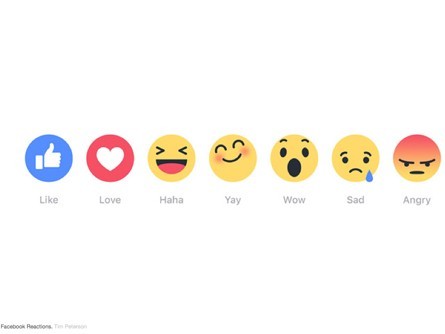
Facebook has decided that the Like button is not expressive enough and are going to add 5 new icons, called “Reactions” that Facebook calls “angry, sad, wow, haha, and love”. Reactions have been tested with users in a number of different countries whilst Facebook observed how they were used, especially during and after events like the terrorist attacks in Paris.
Facebook has come to learn that its users are particularly resistant to any significant changes in the platform, ironically finding it very easy to express their unhappiness with changes that Facebook have made in the past. Adding Reactions could change the “feel” of the site significantly and so Facebook has taken its time in testing user responses.
The many meanings of Like
Facebook’s Like button has become a universal way in which people express some type of reaction to a post on Facebook. In many ways, it is extraordinary that a single symbol can come to mean so many different things. Clicking Like on a sad story might mean that you empathise with the person posting. In another context, it may just be an acknowledgement, either with what was said in the post or simply that you have read the contents.
The trouble is of course that none of this subtlety is conveyed and because of that, its true meaning is lost to the person receiving the like, anyone else viewing the post and the total likes and Facebook themselves. In fact, the total number of likes may include other activities like sharing the post with others or commenting on an article about the referenced post.
The calls for Dislike
Since the Like feature was first activated in 2009, people have discussed whether there should be a “Dislike” button. In 2010 there were addons to Firefox that allowed users to dislike posts on Facebook. The developers explicitly claimed that its principal utility was to express sympathy rather than distaste.
Facebook has largely avoided adding a Dislike button because it was concerned that it might introduce an element of negativity to the site. Certainly there is an element of that happening on sites like YouTube that does have a dislike feature.
The real reason for the need to change
What has probably done most to change the minds of the developers at Facebook about introducing Reactions is the massive move of its users to mobile. In the most recent financial quarter, 80% of Facebook’s advertising revenue came from its mobile platform.
The benefit of something like Reactions on mobile is that they can stand in as shortcuts for the types of comments that users would typically leave. In fact, analysing comments is how Facebook came up with the list of Reactions in the first place. Although close to what is typically thought of by psychologists as basic emotions, there is not a one-to-one mapping between Reactions and human emotions. The psychologist Paul Ekman originally proposed six emotions of: anger, disgust, fear, happiness, sadness and surprise. Users will also only be allowed to select one of the icons which means that the level of expressiveness is never going to be the same as leaving a comment.
And of course, there are the financial reasons
The extension of reaction will be a major boon though to Facebook’s advertising capabilities. Facebook is already extremely sophisticated in how it can target ads to users based on the extensive information that it stores about a user. It is much more likely that users will use Reactions than comment – Facebook’s users click Like 6 billion times a day. This means that Facebook will have a much clearer idea of how individuals perceive posts, photographs and videos and can target their advertising accordingly.
For users of Facebook, they will see Reactions appear over the coming weeks and will be given an opportunity to voice their opinion about them by, well, using the Reactions?
![]()
David Glance, Director of UWA Centre for Software Practice, University of Western Australia
This article was originally published on The Conversation. Read the original article.


COMMENTS
SmartCompany is committed to hosting lively discussions. Help us keep the conversation useful, interesting and welcoming. We aim to publish comments quickly in the interest of promoting robust conversation, but we’re a small team and we deploy filters to protect against legal risk. Occasionally your comment may be held up while it is being reviewed, but we’re working as fast as we can to keep the conversation rolling.
The SmartCompany comment section is members-only content. Please subscribe to leave a comment.
The SmartCompany comment section is members-only content. Please login to leave a comment.